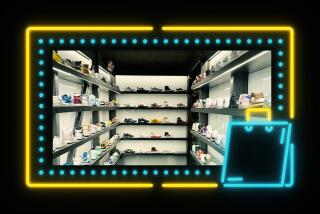Imagine Life Without T-Shirts
Do you ever wake up in a panic in the middle of the night and say, “Oh nuts! I forgot to buy some T-shirts”? Do you find yourself saying, “What I need to do today, right now, immediately, is buy a Scottie-dog refrigerator magnet”? Do you sometimes hear an inner voice crying, “May I have just one ‘Kiss the Chef’ apron before I die?”
If the answer to all these questions is a resounding “No, stupid!” then explain this: Why are there so many gift shops?
Here in America, gifts and T-shirts are our most important products. One nation, devoted to life, liberty and the pursuit of tchotchkes.
Cartoonist Matt Groening is suddenly a multimillionaire on the Bart Simpson T-shirt empire. When he does his “Things I Never Want to See Again From the ‘90s” cartoon, the first item will have to be one of his own Bart shirts.
We seem to have evolved from a manufacturing economy through a service economy into a T-shirt economy. Our gross national product went to $5 trillion, and all I got was this lousy T-shirt.
In fact, my underwear drawer runneth over with T-shirts I never wear. Part of the problem is that most T-shirts are designed for the young male body. I defy you to roll a Hard Rock T-shirt over my soft underbelly.
The graying and spreading of America has dark implications for the T-shirt sector.
But it’s not just T-shirts that are holding up the U.S. economy, it’s the whole panoply of schlock. Look around your town. When the factories closed, what replaced them? Ye Olde Steel Mill Mall--20 unique boutiques, each featuring the same mugs, Mylar balloons, teddy bears, earrings and T-shirts that every other quaint shoppe sells.
You can hardly go into a barbershop or a restaurant or a coffee shop without seeing their very own souvenir T-shirts or mugs for sale: I Got Clipped at Joe’s . . . Le Pavilion Crouton Festival, 1990.
At some point, you want to cry, “ Basta! “--a word you learned from your Basta Pasta T-shirt. For me, that point came when the boutique opened in my local post office.
When the shoe repair and the drugstore and the hardware store in my neighborhood closed and were replaced by gift shops, I got worried. Would the post office be next? But I never considered the possibility that the post office would become another gift shop.
The U.S. Postal Service is now leaving the service sector and branching out into the gift sector. At my post office you can buy T-shirts featuring a postage stamp that shows two tyrannosauruses standing against some purple mountains’ majesty. Pitiful, helpless dinosaur stamps--symbols of the new America.
You can also purchase a teddy bear wearing a postage stamp T-shirt or a toy wooden postal truck. But the main items in the post office boutique seem to be a variety of pins depicting the LOVE stamp. There is a LOVE stamp with a rose, LOVE with a puppy and the word LOVE spelled out in flowers. The post office looks like a Woodstock souvenir stand.
The pins reflect the whole rotten history of the postal service. From LOVE USA 8-centers to the more recent but by no means forever LOVE USA 25-centers.
The most ominous sign for the U.S. economy is printed on each LOVE pin: Made in Taiwan.
OK, we can’t make cars and VCRs. But can’t we even manufacture our own chintzy LOVE pins?
When the boutiquing of the neighborhood began, we called it gentrification. Now, some of the gift shops have failed, and the stores where we once bought our necessities or got things fixed sit empty, with “For Rent” signs on the windows. More and more homeless people have been coming around and sleeping and drinking and begging in the doorways. This is the next stage: de-gentrification.
I think America is finally getting an answer to the question: How many T-shirts, mugs and pins can dance on the head of the economy?






